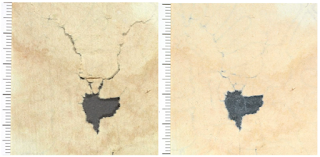News from Diagnostic World: Use of nanocellulose for the restoration of paper
“During a public promotional event, a guy approached a famous writer with the intention of getting to autograph the book he had in his hands. The boy apologized for the conditions in which the book was, the cover was worn, the pages yellowed and some showed tears. He said that this was due to the countless times he had leafed through the pages, bringing with him during his travels. The writer with a smile replied that she was happy that her book had done its job”.
 |
| Figure 1 - The damaged paper (left image) is consolidated and stabilized with the direct application of nanocellulose (right image). |
Mechanical damages such as cracks, gaps and deformations are often present in archival and library material. In addition to being aesthetically unpleasant, they speed up the damage from use. For these reasons, it is necessary, during the restorationworks, to give back integrity to these papers, usually using a Japanese paper and glue. However, in the scientific panorama the use of nanocellulose is increasingly evident. This is a material structurally similar to the paper matrix on which to intervene.
The authors of the article tested two types of nanocellulose with identical molecular structure, but with considerable differences at the morphological level of the fibers:
• bacterial nanocellulose (BNC), synthesized by the bacteria of the Gluconacetobacter species, having a greater capacity for water retention, a higher degree of polymerization and more uniform fibers than the second.
• nanofibrillated cellulose (NFC), isolated from cellulose fibers by a mechanical or chimi-enzymatic-mechanical treatment. Compared to the first, it contains additional components (such as hemicellulose, lignin and other substances) that make it less pure.
On different types of paper (for age and extent of damage), suspensions containing nanocellulose were tested. The latter and the cards have been characterized, physically and chemically, about their optical and microscopic integrity. A part of the samples was subjected to artificial aging.
As you can see in Figure 1, the nanocellulose has allowed to consolidate the damaged areas and close the cracks (while small holes can be coated with a greater amount of nanocellulose). The films formed on the surface of the paper are visible according to the quantity applied; they induce low optical and tactile changes, especially compared to traditional methods. During accelerated aging, the changes that occur are not different from the untreated references.
These two methods, BNC and NFC, thus allow to stabilize the damaged paper structure using exclusively a pure material that has strong similarities, in structure and features, with the original material and which has excellent aging properties.
Once the paper cultural good has been stabilized, it will be able to continue to "live" and be experienced.
The scientific article can be freely read at the following link:
https://heritagesciencejournal.springeropen.com/articles/10.1186/s40494-017-0134-5


Comments
Post a Comment